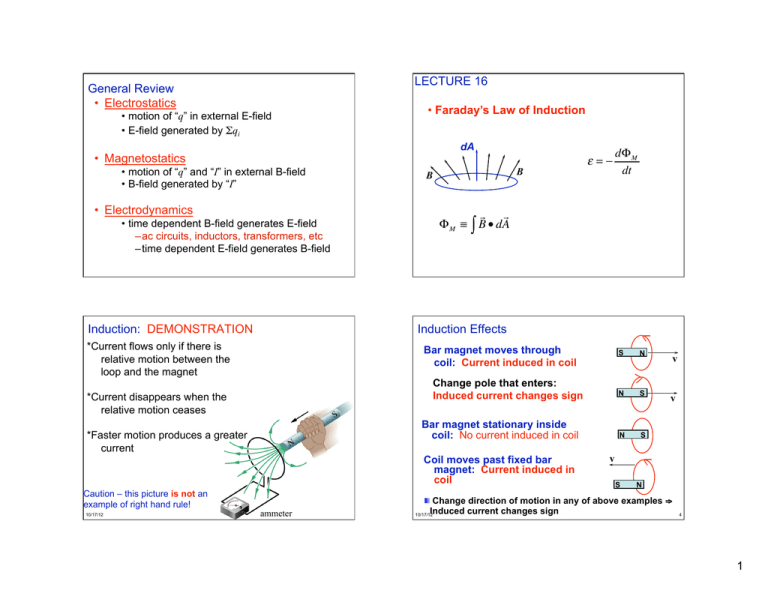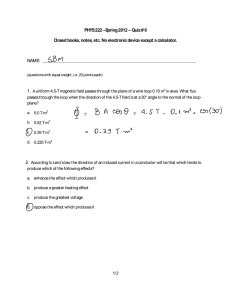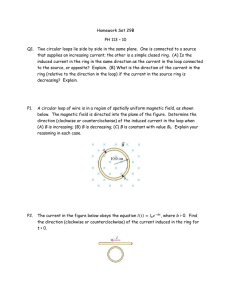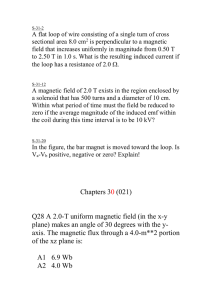1 General Review • Electrostatics • Magnetostatics
advertisement

LECTURE 16 General Review • Electrostatics • Faraday’s Law of Induction • motion of “q” in external E-field • E-field generated by qi dA • Magnetostatics • motion of “q” and “I” in external B-field • B-field generated by “I” • Electrodynamics Induction: DEMONSTRATION Induction Effects *Current flows only if there is relative motion between the loop and the magnet Bar magnet moves through coil: Current induced in coil Change pole that enters: Induced current changes sign *Current disappears when the relative motion ceases Bar magnet stationary inside coil: No current induced in coil *Faster motion produces a greater current 10/17/12 dΦ M dt Φ M ≡ ∫ B • dA • time dependent B-field generates E-field – ac circuits, inductors, transformers, etc – time dependent E-field generates B-field Caution – this picture is not an example of right hand rule! B B ε=− Coil moves past fixed bar magnet: Current induced in coil S N N S N S v v v S N Change direction of motion in any of above examples ammeter 3 Induced current changes sign 10/17/12 4 1 Induction Effects from Currents • When the switch is closed (or opened) b current induced in coil b Induction Example A wire loop falling into a B field (increasing) a Force acting on moving charges time magnetic Field B • Steady state current in coil a downward Velocity v no current induced in coil b • Conclusion: A current is induced in a loop when: there is a change in magnetic field through it. This can happen many different ways. 10/17/12 • How can we quantify this? N 5 Faraday’s Law N 10/17/12 6 Faraday’s Law Restated An emf is induced in a loop when the number of magnetic field lines that pass through the loop is changing. Only components perpendicular to loop dA Define the flux of the magnetic B N B The magnitude of the emf induced in a conducting loop is equal to the rate at which the magnetic flux M through the loop changes. dA field through an open surface A as: Φ B = BA cosθ B B ε=− ΔΦ B Δt Unit: 1 Weber=1Wb=1 Tm2 The minus sign indicates opposition 10/17/12 7 10/17/12 8 2 EMF for a Coil of N turns 10/17/12 How to Change Magnetic Flux in a Coil 9 Lenz’ Law Demo: E&M Cannon An induced current has a direction such that the magnetic field due to the current opposes the change in the magnetic flux that induces the current. Opposition to Flux: B v B 10/17/12 N S N S ΔΦ B ΔB 1. B changes: =N A cosθ Δt Δt ΔΦ B ΔA 2. A changes: = NB cosθ Δt Δt Δ [ cosθ ] ΔΦ B 3. θ changes: = NBA Δt Δt ΔΦ B ΔN 4. N changes (unlikely): = BA cosθ Δt Δt 10/17/12 v 11 • Connect solenoid to a source of alternating voltage. • The flux through the area to axis of solenoid therefore changes in time • A conducting ring placed on top of the solenoid will have a current induced in it opposing this change. • There will then be a force on the ring since it contains a current which is circulating in the presence of a magnetic field. • Note that it’s the off-axis component of B (the “fringe field”) that flings the ring. 10/17/12 10 v B ~ side view 12 3 Faraday’s Law in terms of E Field Summary • Faraday’s Law (Lenz’ Law) x x xEx x x x x x x E xxxxxxxxxx r xxxxxxxxxx B xxxxxxxxxx E x x x x x x x xEx x – a changing magnetic flux through a loop induces a current in that loop ε=− dΦ M dt negative sign indicates that the induced EMF opposes the change in flux • Faraday’s Law in terms of Electric Fields dΦ E ∫ • dl = − dtM 10/17/12 13 10/17/12 14 4





